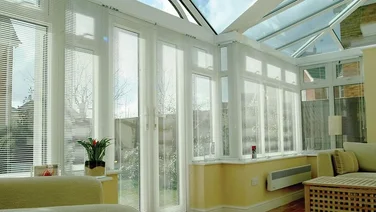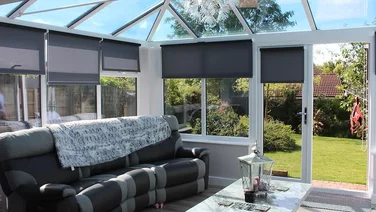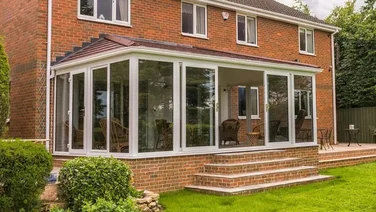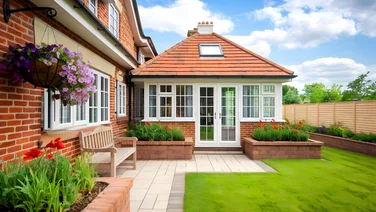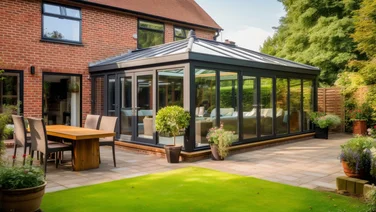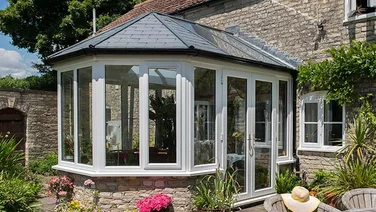- Benefits of a solid roof conservatory
- How much does a solid conservatory roof cost?
- What factors affect the cost of a solid conservatory roof?
- What’s involved in a solid roof conservatory conversion?
- Solid conservatory roof materials
- Solid conservatory roof reviews
- Finding a solid conservatory roof replacement installer
- Do I need planning permission?
- Alternatives to a solid conservatory roof
- Summary
- Solid conservatory roofs offer better insulation, reduced glare and improved durability compared to traditional glass or polycarbonate options.
- While upgrading to a solid roof involves an upfront cost, it can enhance security, aesthetics and long-term usability, making your conservatory feel like a true extension of your home.
- According to Checkatrade, a typical solid conservatory costs between £600 and £900 per square metre

If your property has a conservatory, you may want to upgrade its roof. A solid roof offers many benefits, which we will lay out below.
Thanks to a change in the law in 2010, it is now easier to add to your conservatory. But you must finish the work properly to ensure the walls and frame bear the extra weight.
As well as the detailed information we have here, we have a detailed guide about conservatory roof replacement costs.
Want to skip to the pricing? Start by filling in this form for free quotes on solid conservatory roofs. Once we have your details, we’ll pass them on to our professional installers, who’ll be in touch with their best prices.

Benefits of a solid roof conservatory
They’re comfortable all year round
A conservatory with a glass or polycarbonate (clear plastic) roof can feel like a greenhouse. In the summer they’re really hot;in the winter they find it hard to retain heat. A solid roof will keep the temperature balanced, providing better winter insulation and cooler temperatures when the sun is glaring down.
They look better
A solid roof tends to make a conservatory look more like a part of your house, rather than a lean-to.
Energy saving
By insulating your conservatory roof properly, a solid roof will reduce the money you have to spend heating and cooling it (although the savings will likely not outweigh the cost of building it; see below).
They reduce noise
Solid roofs are generally better at keeping noise out – especially from rain – than thinner, less robust materials.
Greatly reduce glare from the sun
As you can imagine, opaque roofing materials, such as tiles or panels, are excellent ways to reduce sunlight glare. This is useful if you use the conservatory to work, watch TV or look at computer or phone screens.
More secure
As you can imagine, a solid roof is more secure than a glass roof as they are much harder to break into. They also provide more privacy if you have neighbours to the sides or back of your house.
They are very durable
Just like the main roof of your house, a tiled or panelled roof will last a lot longer than other materials, especially those made of plastic.
How much does a solid conservatory roof cost?
A solid conservatory roof can cost anywhere between £600 and £900 per square metre, but the price will vary depending on the size of the conservatory in question. This table gives the following prices for standard sizes of conservatories:
| Conservatory sizes | Average cost* |
|---|---|
| 3m x 3m | £7,800 |
| 4.5m x 2.5m | £9,000 |
| 8m x 3m | £19,000 |
*Prices from DoubleGlazingontheweb
To get an accurate price for your conservatory, you’ll need to have an installer survey your property, as only then will they be able to tell how much work needs to be done. Ensure you get at least three quotes from prospective companies before proceeding.
The price should include disposal of any old materials from the roof, and you should ask if compliance with building regulations is also included. We can help you find qualified installers in your area – just fill out this form.
For comparison, a 3m x 3.5m lean-to conservatory glass roof will likely cost from around £9,500, up to £18,000 for a larger Edwardian-style conservatory. Polycarbonate roofs are normally cheaper: £6,300 for a 3m x 3.5m lean-to and £9,600 for a 4m x 4m Victorian-style conservatory.
Don’t automatically go with the cheapest quote – a poor-quality roof may not last and may result in damage to your furniture, walls and floors if it leaks, gets condensation or falls apart.
Also, don’t assume that a really expensive quote will necessarily result in the best job.You could be utterly ripped off!
What factors affect the cost of a solid conservatory roof?
Several factors will affect the cost of your solid conservatory roof, including:
- the size of the roof.
- the design and style of the roof.
- the style of the conservatory: the more complicated the design, the more expensive the roof will be.
- the type of tiles: for example, concrete tiles cost between £7.50 and £24 per square metre, while slate tiles can cost up to £65 per square metre. You can also use clay tiles, which cost around £30 to £40 per square metre.
- how much work is needed: removal of the old roof, structural work, internal work – such as fitting lighting and wiring – decorating and finishing the ceiling.
- what material any new frames are made of, for example, aluminium and timber will be more expensive than uPVC.
- who your installer is.
- how many windows you are including in the roof, how big they are and what type of glass they’re made from.
What’s involved in a solid roof conservatory conversion?
If your conservatory has a glass or polycarbonate roof, it is important to note that the roof structure will have been designed for these materials only. It may not take the weight of a solid roof without structural improvements.
If this is the case, you may need:
- A new roof frame, such as a timber frame to support the additional weight.
- Posts, beams or lintels to support the new frame
- Work on the foundations, which may not be deep enough; Local Authority Building Control (LABC), the membership organisation for council building control departments in England and Wales, states that you will need a minimum of 15cm of concrete
- New windows or new window and door frames. This is likely if you have uPVC windows with no steel reinforcement. You can test this yourself by holding a magnet against the uprights – a strong attraction means they are probably well reinforced. If your windows and doors are old and not energy efficient, you may decide to replace them anyway, so the heat your new roof keeps in doesn’t escape through the sides.
- Roof ventilation, most probably through vents, to avoid condensation and mould
Solid roofs vary significantly in how much they weigh, and some lightweight tiled roofs weigh around the same as or only slightly more than a double or triple glazed glass roof. The LABC states that increasing the roof’s weight by less than 10% is unlikely to cause structural problems.
However, you must always get all of this thoroughly checked. Any reputable installer will complete a pre-work survey, often for free, before work begins, to assess what alterations are needed. Steer clear of any installer who does not – you don’t want your roof to collapse.
Solid conservatory roof materials
You can choose from several different materials for your solid conservatory roof. These include:
Concrete tiles
These are used on roofs all over the UK and come in various designs and colours, which means you should be able to match them to your main roof. They are also relatively inexpensive. However, they are heavy, so they need adequate support. Some concrete tiles can absorb water, which makes them even heavier during prolonged wet weather.
Natural slate
Natural slate tiles are hardwearing, and many people think they look stylish, but they can be expensive.
Synthetictiles
Made from various materials, including plastic, synthetic tiles are usually very light and hardwearing, and good quality ones look like real slate. They are not usually too expensive and are available in a wide range of colours, sizes and finishes.
Insulated panels
Instead of replacing your roof, another option is to install insulating panels inside the roof. A new timber frame will be installed to support these components, which will then, in turn, be covered with either a uPVC or plaster ceiling attached to its supporting framework. The roof should be thoroughly checked for leaks beforehand, and the panels must be adequately ventilated to avoid condensation.
Solid conservatory roof reviews
The 3 big national firms – Safestyle, Everest and Anglian – all score well on the Trustpilot consumer reviews site.
As of March 2025, Safestyle and Anglian hold joint first place (both holding average review scores 3.9 out of 5). Everest comes in slightly lower with a rating of 3.6 out of 5. There are many other smaller contractors to choose from, but check qualifications and experience, and always read reviews.
In all cases, source at least three quotes before choosing.
Finding a solid conservatory roof replacement installer
Fitting a solid conservatory roof is not a DIY job. You don’t just have to fit the new roof – you have to remove the old one without damaging the conservatory – and make sure the whole structure remains sound.
FENSA, the government’s largest competent person scheme for glaziers, does not cover conservatories. Still, CERTASS does, so as well as looking for LABC and British Board of Agrément (BBA) accreditation, it’s a very good idea to use a CERTASS registered firm.
Members are regularly assessed to ensure their work is of good quality and complies with building regulations. Membership of the scheme also means your guarantee is protected – if the company goes out of business, CERTASS will still honour your warranty.
We recommend getting quotes from at least three companies. Get recommendations from friends and family if you can, and ask for references so you can talk to previous customers.
Before agreeing to any work, ask for an itemised written quotation so you can see exactly what you are paying for. Ask what guarantee the installer offers and what insurance they have.
You can trust The Eco Experts to find local conservatory roofing installers in your area. Just answer these simple questions and get quotes from the best companies around.
Do I need planning permission?
In most cases, you won’t need planning permission to re-roof a conservatory with solid materials. However, you will likely need to seek approval from building control to sign-off once the work is complete.
Since 2010, a conservatory can have a solid roof without planning permission. However, you do need approval from your district or borough council’s building control department. This approval is only for the roof and any associated work, not the whole conservatory.
Any reputable installer should be knowledgeable in this area and able to comply with building regulations. Also look for BBA certification for the roof, ensuring it has been adequately tested for quality and safety.
Be aware that these accreditations are only for the product itself; your conservatory will still need to be assessed to ensure the structure can cope. Ideally, your installer will take care of everything to do with building regulations for you – there is a charge involved whether the installer deals with the council or you do it yourself.
Your installer or the council will give you a certificate confirming that the work complies with building regulations.
Alternatives to a solid conservatory roof
If you don’t want to – or find you can’t – add a solid roof to your conservatory, you could consider these options instead:
- A new roof made of more energy-efficient glass. If you have a polycarbonate roof, you will find glass better at regulating temperature and reducing noise.
- Replacing the windows or doors if they are not energy efficient.
- Installing blinds, tinted glass or tinted polycarbonate to reduce glare from the sun.
- You might even want to consider a new conservatory – it might be a better investment than fitting a new roof on top of old windows and doors that are past their best.
Check out our conservatory roofing materials page for more details on everything from self-cleaning glass to polycarbonate, and be sure to fill in this form for free quotes from local experts.
Summary
- If a solid roof isn’t the right option for you, alternatives such as energy-efficient glass, tinted glazing or full conservatory replacements may be worth considering.
- Adding a conservatory to your home can enhance its aesthetic appeal and functionality, but choosing the right type is essential for year-round comfort.
- A solid conservatory roof provides better insulation, reduces noise and enhances security, making it a popular upgrade over glass or polycarbonate roofing.
- Costs for a solid roof conservatory vary based on size, materials and structural requirements, typically ranging from £600 to £900 per square metre.
- Proper installation is crucial, as additional structural support may be needed to handle the extra weight of a solid roof.
- Planning permission is generally not required, but compliance with building regulations is necessary, so choosing a qualified installer is essential.

